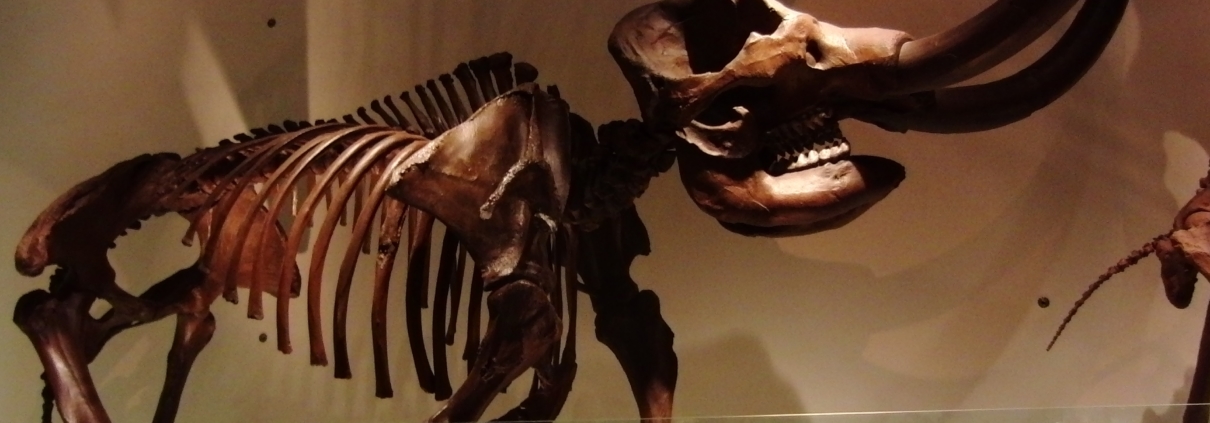“The Mastodon and the Tuscola County Drain”
Michael W. Quaine, P.E.
Imagine sometime between 11,000 to 13,000 years ago, a Mastodon wanders into a bog area on a cold spring day to feed on the local flora. Ice clings to his hair and eye lashes. A small pond, formed from glacial out-melt, beckons him to wade in. A sharp stab wheels him around and he looks for a safe escape route. He staggers towards the bank of the pond and into a muddy, black, and miring mudflat swamp. He touches his side, where the wound is wet with blood. Caught up in the dense mud and vegetation, he closes his eyes, staggers and drops. As the morning light rose, human hunters find him taking his last breath, partially submerged in the mucky water and unmoving. The hunters lay out the site to begin the work of processing the carcass.
Fast forward to 1996 in Tuscola County, Michigan where the S.O. Drain was reconstructed throughout its length. The construction to flatten the side slopes and to widen and deepen the bottom width lasted for two years. The bottom soils were found to be clay soils, intermixed with marl and muck, known in Tuscola as Edwards Muck to denote their poor structure. The S.O. Drain held its form and function well through the next 15 years. The flattened slopes generally remained with robust vegetation. However, the poorly structured soils downstream of Cat Lake were susceptible to erosion and meanders. Sediment bars formed at each point of a meander, creating what little stress is necessary to begin a process of erosion of the fine muck soil. Eventually, into the 2010’s, small bank scours formed in these outer bank areas. Just about 1,400 feet downstream of Cat Lake, on the property of The Fowler Center, in Dayton Township, Tuscola County, the remains of our tragically deceased Mastodon, once again found the light of day.
On the northeast side of the state, the Fowler Center is situated on over two hundred acres. The Fowler Center is licensed as an adult foster care camp and as a children’s camp. They offer year-round programs for children, teens and adults. Emphasis is placed on the ability of each camper to participate in camping experiences according to his or her physical, cognitive and psychological abilities. Their facilities are designed to meet the special needs of their campers. The Fowler Center also rents space to the Tuscola County Intermediate School District for a program called ALP (Alternative Learning Program). This program has teachers and paraprofessionals educating students on site at the Fowler Center. This is the group that made the initial find of bones.
While on a hike in 2014, the teacher and students of the ALP program noticed a large bone protruding from an eroding bank of the S.O. Drain. First opinions varied on the type of animal it represented; from a modern day plow horse to something much more ancient. But once experts examined the specimen, it was clear that the find was an ice age Mastodon.
The Mastodon was eventually determined to be a male of about 30 years. Likely, it dates from 11,000 to 13,000 years ago. The team of paleontologists and volunteers were able to recover about 70% of the animal’s skeleton, including the leg bones, shoulder blades, pelvis, skull, vertebrae and ribs. They did not find the tusks, lower jaw and most of the foot bones. Examination of the remains indicated that there was, in fact, human “interaction” with the animal soon after its death. For this reason, it was expected that the tusks would not be found at the site.
The leader of the site investigation said fewer than 10 of the roughly 300 Mastodon skeletons found in Michigan are as complete as this S.O. Drain Mastodon. “This is the most complete Michigan Mastodon skeleton in many decades,” he said in a news release. He estimates an 80% likelihood that humans “processed” the carcass. The site would have been ideal for the storage and preservation of the mastodon meat. Eventually, the team will radiocarbon date the remains and examine them for signs of butchery. The animal’s wisdom teeth will also be analyzed to try to determine in which season it died.
Considerable excitement accompanied the dig as volunteers and University of Michigan Paleontologists continued to find bone after bone of the animal. As mentioned above, a considerable amount of the animal was found. In fact, this animal is the second most complete Mastodon found since 1940. The excavation foreman even participated in the dig. After noticing the researchers bypass a seemingly ordinary rock repeatedly, he bent down to examine the “rock” and found it very light weight. Surprised at the anomalous density of it, he called over one of the researchers, who excitedly declared it a missing kneecap of the animal. This, I am told, is an important principle of paleontology. “It’s better to be lucky than good!”
Among the first officials brought into confidence was the Tuscola County Drain Commissioner, Mr. Mantey. Having the animal falling out of the banks of his facility did concern the Center. Mr. Mantey was sworn to secrecy until the Center could prepare for the site investigation. The Drain Commissioner worked out his obligations to the Drainage District and he researched the regulations governing the activities to share with the Fowler Center. The bank erosion was one of the reasons for the find, so Mr. Mantey requested that the excavator repair the site erosion once the investigation was done. Then as the Approved Public Agency responsible for soil erosion control, the Drain Commission accepted jurisdiction over the approximately 1/10th acre site during the excavation.
After the excavation was complete, The Fowler Center donated the bones to the University of Michigan Museum of Paleontology. They also have plans to erect a commemorative sign on site containing an explanation of the discovery. The site will remain one of the Center’s popular student (camper) activity. And the story of the uncovering of the fossil remains of one of these impressive animals will be celebrated for years to come.




